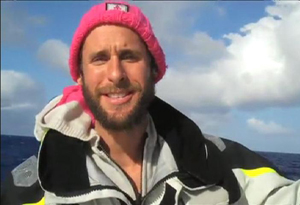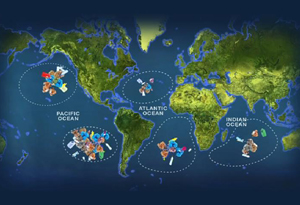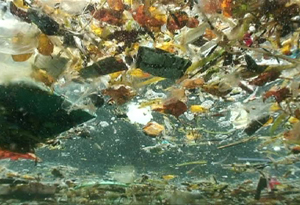Sailing the Pacific on a Plastic Boat

Oprah called it the most shocking thing she's seen. In April 2009, oceanographic explorer Fabien Cousteau exposed the truth about the world's largest trash dump—the Great Pacific Garbage Patch. Estimated to be twice the size of Texas, this trash swirl stretches across the Pacific Ocean from the coast of California to Japan. In some places, the debris is 90 feet deep.
British explorer David de Rothschild, heir to the Rothschild banking fortune, first heard about the Pacific garbage patch in 2006. This ecological disaster, which has killed millions of seabirds and marine mammals, inspired him to build a boat made of 12,500 plastic bottles and other recycled materials. He named it the Plastiki.
Take an exclusive photo tour of the Plastiki.
In March 2010, David and a small team of environmentalists set sail from San Francisco on this one-of-a-kind boat to get people to rethink waste as a resource. This risky voyage will take them through the Great Pacific Garbage Patch before docking in Sydney, Australia.
"We've tried to make everything on this boat as sustainable as possible," David says. "From the energy we use, the food that we eat and the way that we travel."
British explorer David de Rothschild, heir to the Rothschild banking fortune, first heard about the Pacific garbage patch in 2006. This ecological disaster, which has killed millions of seabirds and marine mammals, inspired him to build a boat made of 12,500 plastic bottles and other recycled materials. He named it the Plastiki.
Take an exclusive photo tour of the Plastiki.
In March 2010, David and a small team of environmentalists set sail from San Francisco on this one-of-a-kind boat to get people to rethink waste as a resource. This risky voyage will take them through the Great Pacific Garbage Patch before docking in Sydney, Australia.
"We've tried to make everything on this boat as sustainable as possible," David says. "From the energy we use, the food that we eat and the way that we travel."

While the Pacific garbage swirl is the largest on earth, David says there are actually five floating trash dumps plaguing the world's oceans.
"Anywhere where there is a current in our ocean, the plastic that makes up 90 percent of our marine debris is getting into the ocean," he says. "It aggregates and tends to pack together. So we are seeing a huge accumulation of plastic, these big human fingerprints, in our ocean right now."
David says there are four main polluters in our oceans—plastic bags, Styrofoam cups, Styrofoam containers and soda bottle lids.
"Anywhere where there is a current in our ocean, the plastic that makes up 90 percent of our marine debris is getting into the ocean," he says. "It aggregates and tends to pack together. So we are seeing a huge accumulation of plastic, these big human fingerprints, in our ocean right now."
David says there are four main polluters in our oceans—plastic bags, Styrofoam cups, Styrofoam containers and soda bottle lids.

David and his crew—Jo Royle, David Thomson, Olav Heyerdahl and filmmakers Vern Moen and Max Jourdan—hope their journey makes people realize how garbage is threatening the health of the planet and its inhabitants.
"Every year, hundreds of thousands of marine mammals are needlessly ingesting plastic, little flecks of plastic. That's blocking their system and causing most of the fatalities," David says. "Those little flecks are also being ingested into the fish that we are then consuming. So there's a toxic transfer going on from plastic into fish into us, if we consume fish."
As evidenced by the creation of the Plastiki, David says plastic and other waste doesn't have to end up in a landfill. "Around plastics, we need to reduce, reuse, recycle and the fourth R—refuse the single-use plastics," he says. "I hope that the Plastiki showcases that we've used innovative materials, ... new glues that we've actually engineered out of cashew nuts and sugar, which show that there are solutions to those problems out there. We can all do something about it."
Exclusive videos and photos from the Plastiki crew
"Every year, hundreds of thousands of marine mammals are needlessly ingesting plastic, little flecks of plastic. That's blocking their system and causing most of the fatalities," David says. "Those little flecks are also being ingested into the fish that we are then consuming. So there's a toxic transfer going on from plastic into fish into us, if we consume fish."
As evidenced by the creation of the Plastiki, David says plastic and other waste doesn't have to end up in a landfill. "Around plastics, we need to reduce, reuse, recycle and the fourth R—refuse the single-use plastics," he says. "I hope that the Plastiki showcases that we've used innovative materials, ... new glues that we've actually engineered out of cashew nuts and sugar, which show that there are solutions to those problems out there. We can all do something about it."
Exclusive videos and photos from the Plastiki crew



